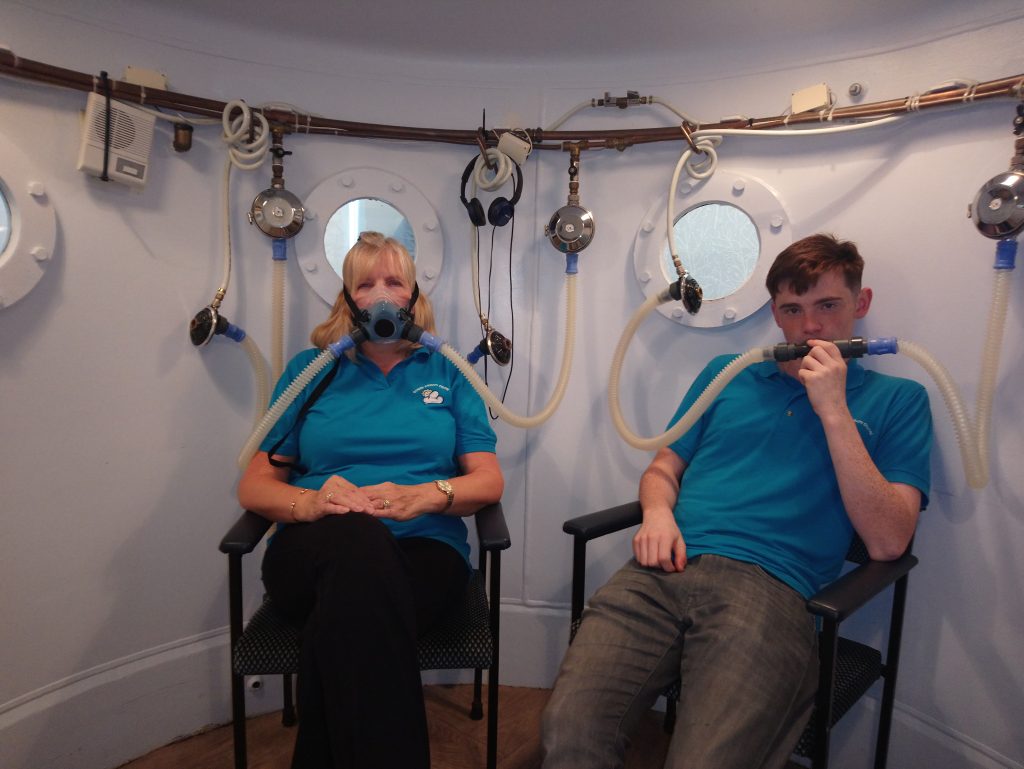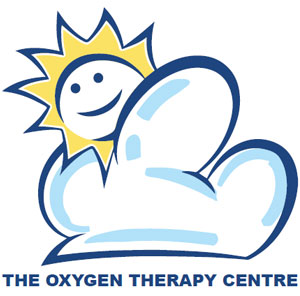HIGH DOSE OXYGEN THERAPY
What is Oxygen Therapy?
High Dose Oxygen Therapy (HDOT) is a recognised medical treatment, proven to enhance the body’s natural healing processes. It has long been used to treat decompression sickness, carbon monoxide poisoning, injuries and wounds and is now being used successfully worldwide in the symptomatic treatment of many neurological, vascular, respiratory and inflammatory conditions such as: –
Multiple Sclerosis, Stroke, Migraine, Cerebral Palsy, Parkinson’s Disease, Dementia, Arthritis, Leg Ulcers, Angina, Circulatory Disorders, Fibromyalgia, Eczema/Psoriasis, Wounds, Sports and other Injuries, Myalgic Encephalopathy (ME) and Chronic Fatigue, Autism, COPD, Asthma, Liver Disease, Post-Operative Healing, Mental Health, and can be used in conjunction with conventional medical treatments.
Oxygen Therapy is used as an adjunct therapy when Cancer patients are having Chemotherapy and Radiotherapy. Oxygen under hyperbaric conditions may enhance the delivery of oxygen to hypoxic tumour cells, thereby increasing their sensitivity to radiation and chemotherapy.

FAQ’s
What is high dose oxygen treatment?
High Dose Oxygen Treatment (HDOT) most commonly refers to the delivery of increased levels of oxygen at greater than ambient pressure for a prescribed duration of usually 60 to 90 minutes.
The air we normally breathe contains 21% oxygen, 78% nitrogen, with the remaining 1% being contributed by the noble gases and carbon dioxide. The concentration of these gases is determined by the atmospheric pressure which is determined by the weather and is reduced at altitude. Unfortunately, the variations in this pressure are ignored in general medical practice. Atmospheric pressure is accorded the unit 1 to represent atmospheric pressure absolute (1ata) and this unit is divided according to the percentages of the gases in air to give their ‘partial pressures’ that is the part of the total pressure each gas is responsible for – oxygen therefore being 0.21 ata (21% of 1) and nitrogen 0.78 ata (78% of 1).
A hyperbaric chamber is needed to allow the pressure around the body to be increased. The technology is very well established, in fact all commercial aircraft are hyperbaric chambers equipped with oxygen breathing systems.
How does breathing more oxygen help?
The air that we breathe usually provides enough oxygen for both normal body metabolism and repair to tissue damage after injury or illness. However increasing the pressure surrounding a client in a chamber using 100% oxygen can allow a very significant increase in the amount of oxygen dissolved in the bloodstream. This is in addition to the oxygen carried by haemoglobin. Normally the atmospheric pressure (2 ata) breathing 100% oxygen this increases to 3 ml oxygen in 100 ml blood. The increased concentration means that the gradient for the transport of free oxygen from blood into the tissues is increased 10 fold.
When tissues are damaged the capillaries within the tissues are also damaged which increases the distances for oxygen to diffuse. This can lead to a severe oxygen deficit in the tissues even when the amount of oxygen carried in the blood is normal. The object of using the increase in pressure and oxygen concentration is to raise tissue oxygen values towards normal to initiate normal cellular repair mechanisms. In fact oxygen, like glucose and water is an essential substrate.
How does HDOT lead to tissue recovery?
Oxygen is dissolved in the blood and transported, in combination with haemoglobin in the red blood cells throughout the body. This dissolved oxygen passes into the tissues. Breathing high levels of oxygen under hyperbaric conditions causes greater uptake of oxygen by the bodily fluids and so more can reach areas where the circulation is diminished or blocked and therefore improve recovery. The extra oxygen has additional benefits as it greatly enhances the ability of white blood cells to kill bacteria. It also reduces swelling and allows new blood vessels to grow more rapidly into the affected areas.
Severe tissue hypoxia (oxygen deprivation) has many adverse effects from abolishing normal cell activity as, for example, with loss of consciousness to disabling normal cell activity in infection. Only the administration of oxygen can ‘treat’ hypoxia and the objective of the administration of oxygen is to establish tissue oxygen values compatible with the initiation of normal healing.
How is HDOT administered?
HDOT is a simple, non-invasive and painless treatment which most clients find comfortable and relaxing. You will be treated in a secure and comfortable purpose built chamber with a trained operator present to operate the barochamber. In certain circumstances the attendant will accompany clients into the chamber. There has been no recorded case of a client suffering either a heart attack or a stroke undergoing high dose oxygen treatment, and oxygen under hyperbaric conditions can be used as a treatment for both conditions.
On entering the chamber clients will be seated in a comfortable chair. It is recommended that you wear comfortable clothing and leave any jewellery or watches outside. No smoking materials, matches or lighters are allowed in the chamber.
The treatment session is conducted in three phases:
Compression:
Once the door is closed, there will be some noise as the pressure increases. It will get warmer and you will feel fullness in your ears similar to when descending in a aeroplane. You will have taught how to avoid discomfort by clearing or ‘equalising’ your ears. As soon as the chamber pressure increases, you will need to start making your ears ‘pop’. There are several ways to do this and the chamber attendant will find the best way that suits you. Some people find that swallowing is sufficient. If you develop any discomfort inform the attendant and the rate of compression will be reduced. There may be a few unusual noises but this is normal as the chamber ‘descends’.
Treatment:
On reaching the desired pressure (usually 1.5 to 2.0 ata) the client uses a mask, mouthpiece or hood and breathes oxygen for the duration of the session. The treatment begins when the pressure reaches the prescribed level. You may then rest, sleep, read or watch television. The mask or mouthpiece can be removed occasionally and the chamber can be decompressed at any time if necessary.
After the prescribed amount of time has elapsed the attendant will let you know when the treatment is complete and the pressure will be lowered slowly, at a rate that is comfortable. A session usually lasts just over an hour and can be repeated daily. If a client is receiving two treatments a day the second treatment follows the first after a three to four hour break outside the chamber.
What are the benefits of High Dose Oxygen Therapy?
High Dose Oxygen Therapy significantly:
- enhances the ability of white blood cells to kill bacteria and prevent infection
- increases the supply of oxygen to injured and diseased areas
- reduces swelling, pressure and pain
- promotes the repair of injuries
- improves the rate at which lactate and ammonia levels return to normal after exertion so boosting energy and performance levels and minimising stress and fatigue
Reported benefits of HDOT are improvements in:
- circulation
- vision
- speech
- memory and concentration
- balance and coordination
- bladder and bowel control
- pain and stress levels
- energy levels
- mood and sense of well-being
Are there any dangers or unwanted side effects with High Dose Oxygen Therapy?
Some people may experience temporary ear discomfort, tiredness and slight blurring of vision particularly during the first few sessions. This is not unusual and may persist in some for up to a few weeks but does clear in time. There have also been some reports of aching teeth but this is slight and temporary.
There are no contraindications to HDOT, except pneumothorax and acute ear or sinus infections. You should always consult with your GP and/or Medical Practitioner before engaging in our therapies.
General guidance, especially on treatment protocols and the likelihood of benefit is obtained from the Coordinator of the Oxygen Helpline, Petra Kliempt BSc MPH PhD, who is Honorary NHS Specialist Trainer in Hyperbaric Medicine. The Oxygen Helpline and MS National Therapy Centres are also assisted by the Hon. Medical Adviser Emeritus Professor Philip B. James, MB, ChB, PhD, DIH, FFOM.

Appointments
